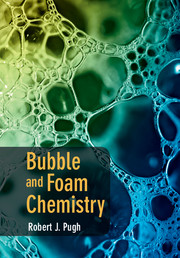Book contents
- Frontmatter
- Contents
- Preface
- Acknowledgments
- List of symbols
- 1 Basic principles and concepts
- 2 The nature and properties of foaming surfactants
- 3 Soap bubbles and thin films
- 4 Processes in foaming
- 5 Generation of bubbles and foams
- 6 Coalescence of bubbles in surfactant solutions
- 7 The stability/instability of bubbles and foams
- 8 Particle-stabilized foams
- 9 Foaming in non-aqueous liquids
- 10 Antifoaming and defoaming
- 11 Bubble size measurements and foam test methods
- 12 Bubble and foam chemistry - new areas of foam research
- Index
- References
4 - Processes in foaming
Published online by Cambridge University Press: 05 September 2016
- Frontmatter
- Contents
- Preface
- Acknowledgments
- List of symbols
- 1 Basic principles and concepts
- 2 The nature and properties of foaming surfactants
- 3 Soap bubbles and thin films
- 4 Processes in foaming
- 5 Generation of bubbles and foams
- 6 Coalescence of bubbles in surfactant solutions
- 7 The stability/instability of bubbles and foams
- 8 Particle-stabilized foams
- 9 Foaming in non-aqueous liquids
- 10 Antifoaming and defoaming
- 11 Bubble size measurements and foam test methods
- 12 Bubble and foam chemistry - new areas of foam research
- Index
- References
Summary
Evolution thus is merely contingent on certain processes articulated by Darwin: variation and selection.
Ernst Mayr, What is Evolution, Science Masters Series/Basic Books, Oct 2001.Overview of processes
The evolution of foams occurs through a series of rapid non-equilibrium processes which can be observed by sparging gas through a glass sinter into a column of water. As the air bubbles ascend, their velocities are principally determined by their sizes, the difference in the viscosities of the liquid and gas phases and the properties of the gas/liquid interface. However, as the bubbles grow in size, they may collide and in cases where only weak foaming agents are present in solution, compaction and coalescence can occur. There are several other processes which play an important role in determining the characteristics of the bubbles and the structure of the foam as the bubbles accumulate at the interface. For example, the drainage process or the downward flow of liquid coupled with liquid flow into the Plateau borders can cause thinning of the liquid films. Also, repulsive interactions across the thin film lamellae resulting from strongly adsorbed chemical surfactants can slow down drainage or even prevent bubble coalescence. During the ascent and mixing of bubbles, another important process known as disproportionation occurs. This involves the diffusion of gas from smaller to larger bubbles, and the driving force for this process is the Laplace pressure (the pressure difference between bubbles of different sizes). Although the term “disproportionation” is commonly used by chemists to describe inter-bubble gas diffusion within foams, it is often referred to as Oswald ripening, which was originally used to define the evaporation–condensation mechanism in two-phase separation of binary alloys. The term “coarsening” is often used but coarsening is also frequently considered to be a combination of inter-bubble gas diffusion and coalescence. This confusion in terminology is due to the fact that researchers engaged in foams come from a variety of disciplines, and each has its own terminology. An overview of some of the processes that occur during sparging are outlined in Fig. 4.1.
Molecular processes such as the adsorption and the mobility of chemical surfactant molecules at the air/water interface and also the depletion of surfactant from solution can occur at high gas flow rates can also influence the stability of the bubbles.
- Type
- Chapter
- Information
- Bubble and Foam Chemistry , pp. 112 - 154Publisher: Cambridge University PressPrint publication year: 2016



